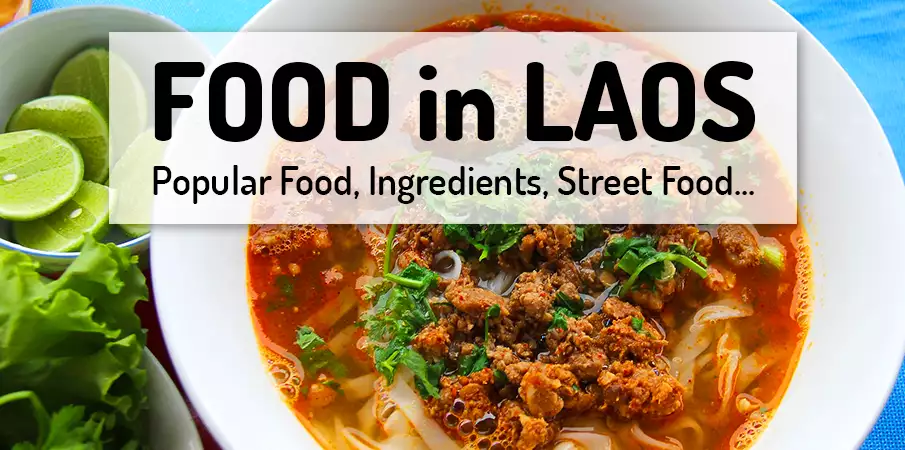
1. Cuisine in Laos
2. What to Expect
3. Popular Dishes
4. Spices + Ingredients
5. Regional Variations
6. Food as an Event
7. Fruit + Vegetables
8. Beverages + Alcohol
9. Street Food in Laos
10. FAQs + Answers
Tasting Traditions in the Cuisine and Foods of Laos:
In the heart of Southeast Asia lies a small country that holds a gastronomic gem – Laos. Even tourists from Vietnam venture into this land for another adventure in Asian cuisines. Despite its culinary heritage appearing modest, it conceals a wealth of taste mysteries and traditions that stretch across generations. Step into a world where sweet blends with savory, and sour with spicy, and discover the richness of Laotian Cuisine.
Rice: Fundamental Treasure of Laotian Cuisine
-
- Laos and rice – a connection so strong that one could imagine these grains as the very heart of the land. Sticky rice, carefully harvested from Laotian rice fields, is not just a complete meal but also symbolizes social bonds, tradition, and sustenance. It’s more than just a side dish; it’s the cornerstone on which the wealth of flavors in Laotian cuisine rests, much like in Vietnam.
Harmony of Tastes: Sweet, Salty, Sour, Spicy
-
- In Laotian cuisine, flavors fear no experimentation and combination. Their secret lies in the harmonious blend of sweet, salty, sour, and spicy. Each bite brings an unparalleled symphony of tastes to the palate, making the meal not only a culinary experience but also a display of creativity and sensuality.
Fresh Herbs and Spices: Secret Weapons of Laotian Dishes
-
- Revitalizing the taste buds in Laotian cuisine involves the use of fresh herbs and spices. Galangal, lemongrass, and kaffir lime leaves act like magical ingredients that add complexity and distinctiveness to dishes. These secret weapons are masterfully utilized to create unique taste profiles.
Delightful Treasures: Laap, Tam Mak Houng, and Mok Pa
-
- Laotian cuisine introduces us to delightful treasures that captivate even the most discerning taste buds. Laap, minced meat combined with fresh herbs and spices, presents a harmony of flavors in one dish. Tam Mak Houng, spicy papaya salad, offers a refreshing journey into the world of contrasts. Mok Pa, a fish specialty served in banana leaves, entices our senses with its aromatic essence.
BOOK a TOUR / ACTIVITY in Laos ➜
What to Expect from Laotian Cuisine and Dishes:
While exploring the beautiful land of Laos, tourists can look forward to a diverse and flavorful adventure in the world of Laotian cuisine. Here are some useful tips to fully enjoy the gastronomic side of this fascinating destination:
Rice on Every Table: Symbol of Community
-
- Explore not only various types of rice but immerse yourself in the culture of communal dining. Rice is not just a meal; it’s a symbol of connection and hospitality. Prepare for a sticky, fragrant, and unique rice palette.
Harmony of Tastes: Try All Contrasts
-
- Laotian cuisine is characterized by a harmonious blend of contrasting flavors – sweet, salty, sour, and spicy. Don’t hold back and try as many different dishes as possible. The delightful combinations are sure to surprise you.
Local Specialties: Embrace New Experiences
-
- Try local specialties such as laap, the spicy papaya salad Tam Mak Houng, or the fish delicacy Mok Pa. Laotian cuisine offers unique taste experiences worth discovering.
Respect Local Customs: Even in Food
-
- Respect local customs when dining. Say thank you after the meal and enjoy the shared time at the table. Food in Laos is not just about nourishment but also about sharing and experiencing together. Remember that trying the local cuisine is not just about the food but also about exploring the culture.
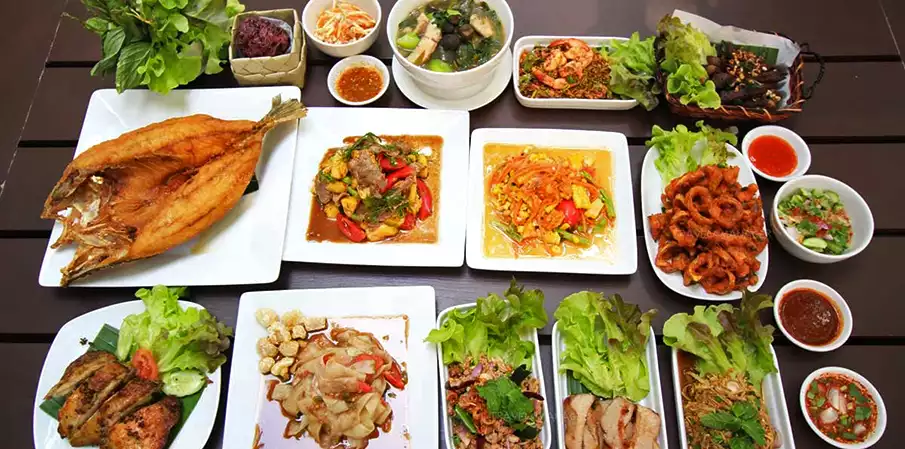
Delicacies and Favorite Dishes in Laotian Cuisine:
Laap – Flavor Symphony with Minced Meat
-
- Laap is perhaps the most well-known and beloved dish in Laos. This flavor symphony combines minced meat (often beef or chicken) with refreshing herbs and spices. The result is an intense blend of flavors that captivates anyone who decides to taste this Laotian delicacy.
Tam Mak Houng – Spicy Papaya Salad
-
- Prepare for a refreshing explosion of flavors with Tam Mak Houng. This spicy papaya salad is made with fresh vegetables, chili, peanuts, and other delightful ingredients. Its spicy and fresh nature makes it irresistible for those seeking an interesting taste adventure.
Mok Pa – Fish Specialty in Banana Leaves
-
- Mok Pa showcases the mastery of Laotian cuisine in preparing fish dishes. The fish is mixed with aromatic herbs and spices, then wrapped in banana leaves and gently cooked. This tradition gives Mok Pa a unique taste and aroma that takes you straight to the heart of Laotian culinary traditions.
Khao Piak Sen – Homemade Rice Noodles
-
- For noodle enthusiasts, Khao Piak Sen is almost a must-try. These homemade rice noodles, crafted from fresh dough, are often served in beef broth with a variety of toppings such as fresh herbs, chili, and lime. The result is a warm and invigorating dish that warms not only the body but also the soul.
Or Lam – Traditional Delight from Northern Laos
-
- Or Lam is an authentic delight originating from the mountainous regions of northern Laos, winning the hearts of locals and visitors with its unique blend of flavors and traditional preparation. It is a rich dish that brings together various types of meat, vegetables, and aromatic herbs, making it a distinctive representative of Laotian cuisine.
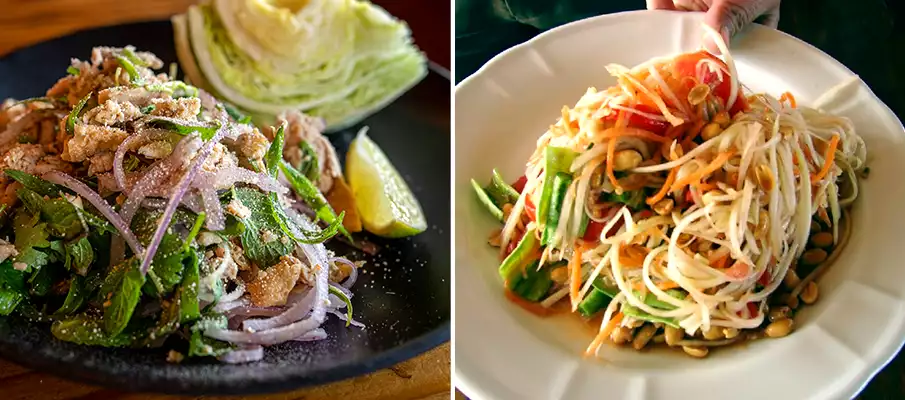
Popular Spices and Ingredients in Laotian Cuisine:
Laotian cuisine entices with its spicy and rich flavor profile, thanks to carefully selected spices. Here are some of the key spices and ingredients that form the backbone of this culinary tradition:
-
- 1. Chilies: Chilies are an essential element in Laotian culinary art. Varieties of peppers are used, ranging from mildly spicy to incredibly hot. They add a warming spiciness and distinctive flavor to dishes.
- 2. Horseradish Sauce: Horseradish sauce, also known as „Jeow,“ is prepared from horseradish, fish sauce, garlic, and chilies. This notably spicy sauce is often used as a dip or seasoning for rice and meat.
- 3. Spicy Sauces: Various spicy sauces, including fish sauce or tamarind sauce, are integral to Laotian recipes. They not only add spiciness but also complexity to the flavors of the dishes.
- 4. Turmeric: Turmeric is utilized for its golden color and subtle spicy undertones. It is added to various curry mixes and dishes, contributing to both visual appeal and taste.
- 5. Spices: A selection of spices like pepper, coriander, and cardamom also plays a crucial role in Laotian cuisine. These aromatic ingredients enrich the flavor profile of dishes, adding depth.
- 6. Galangal (Galangal Root): Similar to ginger, galangal has a distinct citrusy taste and mild spiciness. It is often used in soups, sauces, and curries, providing aromatic depth to dishes.
- 7. Lemongrass: Lemongrass brings a refreshing citrus taste and aroma to Laotian dishes. It is popular in making soups, salads, and some meat dishes.
- 8. Kaffir Lime Leaves: Kaffir lime leaves are a key ingredient that imparts the characteristic citrus taste to dishes. They are often added to curries, soups, and certain sauces.
Spices in Laotian cuisine not only awaken the taste buds but also reflect the passion and creativity of local chefs. Prepare for a flavor explosion and savor an unforgettable culinary adventure in the heart of Southeast Asia.
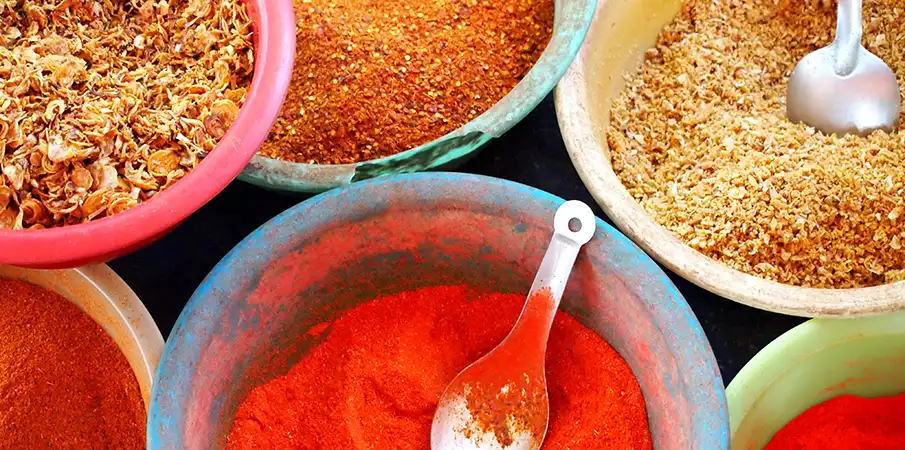
Regional Variations of Dishes and Cuisine in Laos:
Laos, a country surrounded by mountains and lush landscapes, not only boasts beautiful nature but also carries rich cultural heritage reflected in regional variations of local dishes. Exploring the regions of Laos reveals the unique diversity offered by each part of the country.
Northern Laos: Local Farming Traditions
-
- In the mountainous areas of northern Laos, meals are crafted based on available ingredients such as mushrooms, bamboo shoots, and wild game. Traditional dishes like „Khao Poon,“ noodles served in a spicy soup, reflect the simplicity and authenticity of rural life.
Central Laos: Historical Influences and Fishing Traditions
-
- Central Laos, the region around the capital city Vientiane, reflects historical influences and is enriched with fishing traditions. „Mok Pa,“ a fish dish cooked in banana leaves, is a common delight here. Fish, salted and spiced, are wrapped in leaves and slow-cooked, creating a delightful taste with a touch of exoticism.
Southern Laos: Flavor Harmony and Spicy Freshness
-
- Southern Laos welcomes you with its subtle and spicy dishes. Traditional „Laap“ is prepared here with spicy herbs like mint and coriander, giving the dish a distinctive and refreshing taste palette. Rice, a natural complement to every meal, is often served in sticky form.
Southwestern Laos: Vietnamese Influence and Exoticism
-
- The southwestern part of Laos, bordering Vietnam, bears the influence of Vietnamese cuisine. „Bánh Mì Lao,“ a Laotian variation of the famous Vietnamese sandwich, is a popular dish. Local chefs here often experiment with exotic ingredients such as durian and various types of seafood.
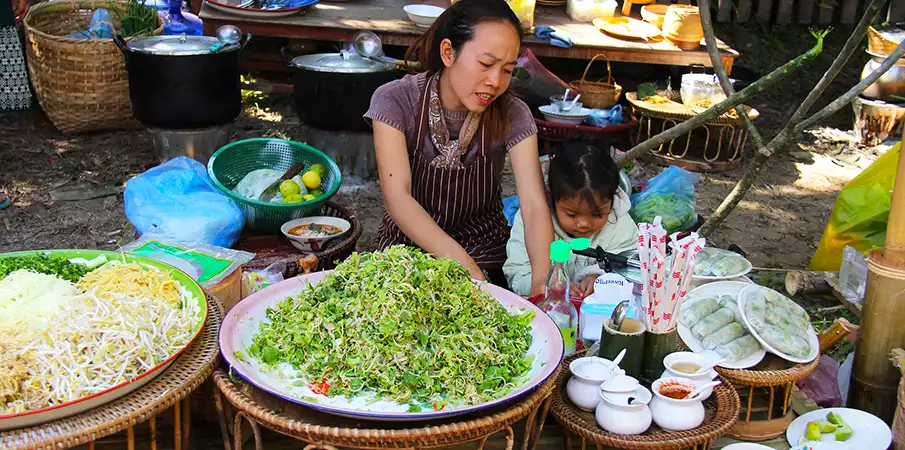
Laotian Cuisine as a Social Event:
Laotian cuisine not only warms the stomach but also brings people together during social events, family gatherings, and religious rituals. Food plays a significant role in daily life in Laos and is a symbol of connection and prosperity.
Celebrations and Family Gatherings:
-
- During celebrations and family gatherings, food is an integral part of Laotian culture. Large family gatherings are often associated with rich platters filled with traditional Laotian dishes. This not only provides an opportunity to savor delicious specialties but also creates an atmosphere of sharing and joy.
Religious Rituals and Ceremonies:
-
- Laos is a land of deep spirituality and religious traditions. In Buddhist ceremonies and monastery festivals, food becomes an essential part of the rituals. People offer food as a sacrifice to express gratitude and devotion. Religious celebrations are thus associated with feelings of sharing and community.
Traditional Laotian Dining Customs:
-
- Laotian people place great emphasis on politeness and respect towards food. Traditional dining in Laos involves the communal serving of dishes in shared bowls, emphasizing the importance of sharing. Hosts show care for their guests by sharing everyday bread with them, creating an environment of friendship.
Symbolic Significance of Food:
-
- Food in Laos also carries symbolic significance. For example, rice is considered a fundamental source of life and symbolizes abundance and prosperity. Rituals associated with the preparation and consumption of food reflect a deep respect for sustenance and a connection with nature.
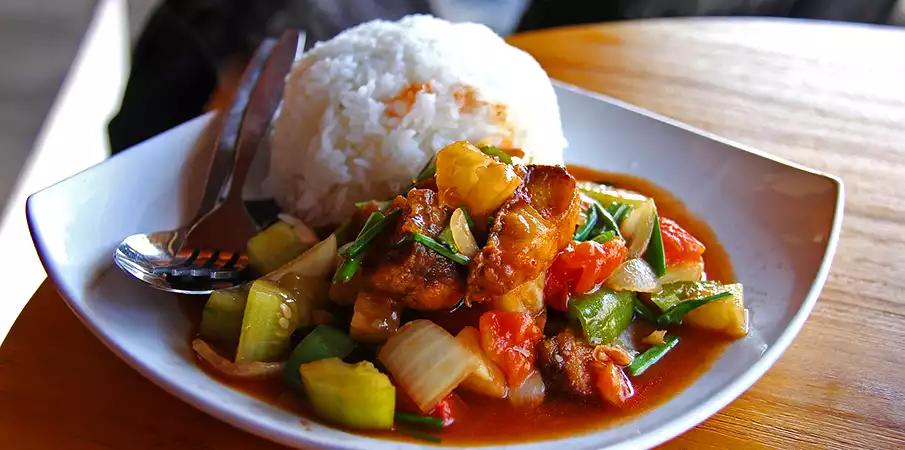
Fruits and Vegetables in Laos as Culinary Ingredients:
Laos, a land of green mountains, rivers, and valleys, hosts a rich palette of fruits and vegetables that reflects the fertile soil and tropical climate of this Southeast Asian destination. Looking at a Laotian table, we discover that fruits and vegetables are not just part of the diet but are key players in the Laotian culinary scene.
Favorite Fruits in Laos:
-
- Durian: Durian is considered the king of fruits, as the name suggests. This massive fruit has creamy flesh with an intense taste and a strong, sometimes controversial aroma. While some may be put off by its smell, for locals, durian is a culinary experience full of rich flavors.
- Mangosteen: Mangosteen, known as the queen of fruits, offers sweet and juicy white segments hidden beneath a red, leathery rind. Its taste is delicately refreshing and is often considered the most delicious fruit in Southeast Asia.
- Rambutan: Rambutan, resembling lychee, is an exotic delight with sweet, juicy flesh. The red skin with soft fibers conceals delightful white meat, making it an irresistible experience for fruit enthusiasts.
- Pineapple: Pineapple, sweet and refreshing, is a common fruit in Laos. Its fresh taste is used in making juices, salads, and traditional dishes. Ripe pineapple presents a combination of sweetness and mild acidity.
- Bananas: Bananas are available in various varieties in Laos, from smaller sweet ones to larger and more complex in taste. They are a common part of everyday meals and are often consumed fresh or used in cooking.
Favorite Vegetables in Laos:
-
- Bamboo Shoots: Bamboo shoots are a popular vegetable in Laos, valued for their tender texture and ability to absorb the flavors of other ingredients. They are a common element in dishes such as curries and soups.
- Legumes: Legumes, such as lentils and beans, form an essential part of Laotian cuisine. They are rich in protein and are often used in various traditional dishes and soups.
- Eggplant: Eggplant is a versatile vegetable in Laos, known for its slightly sweet taste. It is often part of curries and sauces, adding interesting texture and richness to dishes.
- Okra: Okra, a vegetable with a unique structure and slight sliminess, is popular in Laos for its thickening ability and distinctive taste. It is often used in traditional Laotian dishes and soups.
- Nettle: Nettle is a traditional vegetable that adds a unique taste to dishes and is rich in nutrients. In Laos, it is often consumed as part of salads and sauces.
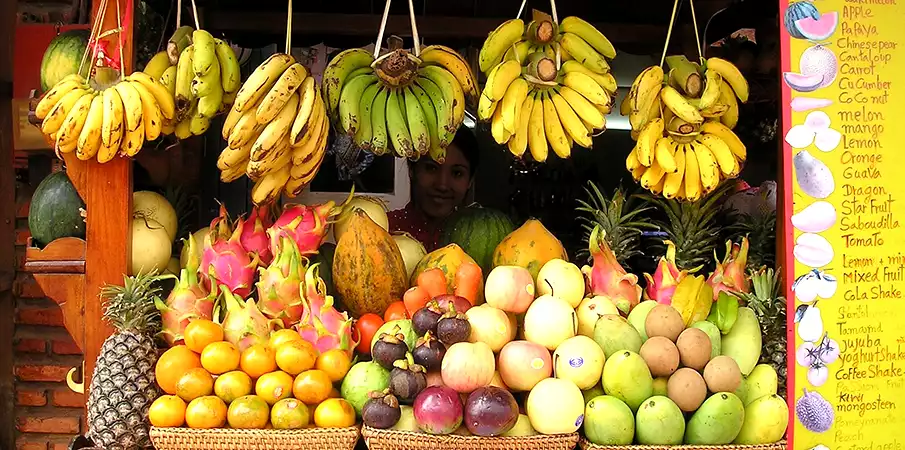
Favorite Local Drinks and Alcohol in Laos:
Laos, the land of a thousand temples and picturesque landscapes, is not only about rich culture and breathtaking scenery but also about the diversity of beverages and traditional alcohol that reflects local tastes and customs. While strolling through the streets of Laos or sitting at a local food stall, one cannot help but enjoy the unique array of drinks that are an integral part of everyday life.
Local Favorite Drinks in Laos:
-
- Laos Coffee: Laos coffee is characterized by its intense flavor and aromatic profile. It is often prepared using the drip method known as „kaafe bor,“ resulting in strong black coffee, or „kaafe yen,“ iced coffee ideal for hot Laotian days. Coffee enthusiasts will appreciate the quality of Laotian beans, giving the cup a unique character.
- Sugarcane Juice: Fresh sugarcane juice is a popular beverage in Laos, especially during the hot season. Its sweet taste provides a pleasant escape from the tropical sun. It is prepared by pressing juice from fresh sugarcane, ensuring a pure and refreshing flavor.
- Fruit Shakes: Fruit shakes are common in Laotian markets and refreshment stalls. Blended fruits such as bananas, mangoes, or pineapples become a refreshing drink for those seeking a cool experience. The advantage is that you can choose your favorite fruits and create your own flavor combination.
- Iced Tea: Cold tea, often sweetened and flavored with lemon, is a popular drink in Laotian restaurants. Locally grown tea leaves bring a subtle bitterness to the drink with a refreshing twist of lemon.
- Fresh Coconut Water: Fresh coconut water straight from the nut is a common drink in Laos. The coconut provides a refreshing liquid with a pleasant taste palette. While passing through the markets, you can see locals indulging in this natural refreshment.
Alcoholic Drinks in Laos:
-
- Lao-Lao: Lao-Lao, a traditional rice spirit, has deep spicy and sometimes sweet tones. It is often homemade and can be a key element in Laotian rituals and festivities.
- Beerlao: Beerlao, the Laotian beer brand, is a significant player in the Laotian alcoholic scene. Its refreshing taste and quality are characteristic of this local drink, which you can enjoy in many pubs and restaurants.
- Lao-Hai: Lao-Hai, rice wine, is created by fermenting rice, resulting in its sweet and slightly sour taste. It is popular during family celebrations and traditional ceremonies.
- Mekong Whiskey: Mekong whiskey is a type of whiskey produced in the region around the Mekong River. Its strong flavor is popular among locals.
- Lao Beer: Lao Beer, another well-known Laotian beer brand, is favored for its taste and quality. You can enjoy it as a companion to local meals or while socializing with friends in one of the many Laotian pubs.

Exploring Popular Street Food in Laos:
Street food in Laos is not just about buying food; it is an adventure for your taste buds and a cultural experience that will stay in your heart forever. Laotian street cuisine is characterized by unique flavors that blend traditional recipes with modern influences. Every corner offers a wide range of delights, from crispy baguettes filled with street stall ingredients to aromatic soups that warm the soul.
-
- Khao Jee Sandwich: Khao Jee Sandwich, a local variation of the baguette, is your first step into the world of taste contrasts. Crunchy bread filled with raw vegetable shreds and roasted meat creates a unique harmony of flavors.
- Laos Noodle Soups: The Laotian version of the beloved pho is a comforting soup that combines fresh broths with hearty noodles and fresh vegetables. With each spoonful, you’ll feel the aroma and richness of tradition.
- Som Moo: Som Moo, dried and smoked slices of pork, presents the Laotian interpretation of traditional salami. Sampling Som Moo will immerse you in the salty and spicy world of flavors.
- Khao Piak Sen: Homemade noodles, known as Khao Piak Sen, are rich and delicate, offering a journey into the world of comforting and satisfying food. With every bite, you’ll sense Laotian love for traditional cuisine.
Culinary Kaleidoscope in the Streets of Laos:
-
- Laotian street stalls are not just places to buy food. They are vibrant scenes where you become part of local life, sharing the joy of simple but tasty dishes. The diversity of street food in Laos creates a culinary kaleidoscope where traditional flavors intertwine with modern trends.
- Each dish brings a new layer of aromatic scents as street chefs and vendors begin preparing their masterpieces in front of you. The fragrance of fresh herbs, coconut oils, and exotic spices will draw you into this gastronomic adventure.
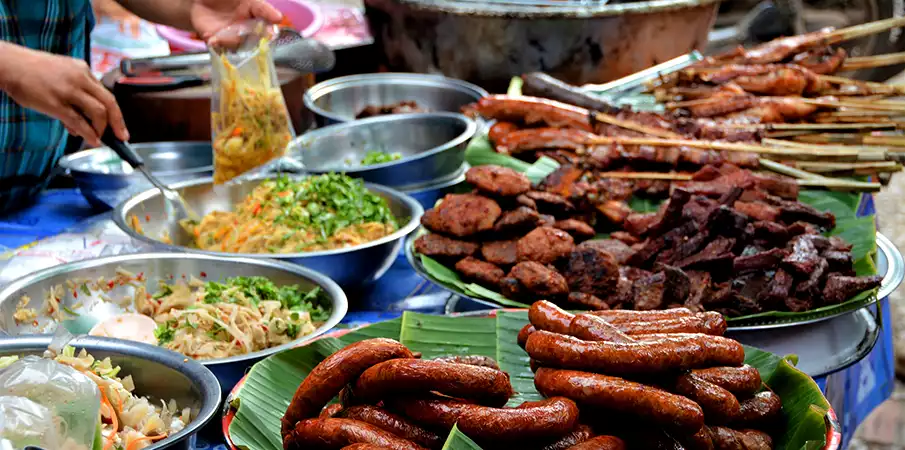
10 Most Popular Dishes in Laos Among Tourists:
1. Laap (Larb):
Laap, also known as Larb, is an iconic Laotian dish consisting of minced meat (often chicken or beef), mixed with fresh herbs, lime juice, and spicy seasoning blends. This rich blend of flavors and textures creates an irresistible taste explosion.
2. Sticky Rice (Khao Niew):
Sticky Rice, or Khao Niew, is not just a side dish in Laos but rather the foundation of every meal. Served in bamboo baskets, this sticky rice dish is an integral part of Laotian cuisine.
3. Tam Mak Houng:
Tam Mak Houng, or green papaya salad, is a popular choice for those who want to taste a slightly sour and refreshing delicacy. Papaya is mixed with tomatoes, beans, peanuts, and spiced with spicy sauces.
4. Mok Pa:
Mok Pa is a Laotian dish that combines fish, herbs, and spices, all wrapped in banana leaves and steamed. This aromatic dish provides a unique experience for the taste buds.
5. Khao Poon:
Khao Poon is a delicious soup that combines bold curry with coconut milk, noodles, and various types of meat. This warm and rich soup is especially popular in cooler seasons.
6. Or Lam:
Or Lam is a Laotian beef stew that combines meat, spices, and vegetables in a thick, aromatic pot. This flavor-rich specialty is often served with sticky rice bread.
7. Ping Kai:
Ping Kai, or grilled chicken wings, are a popular street food in Laos. Marinated in a spice mix and grilled over an open fire, this simple delight entices with its crispy exterior and rich flavor.
8. Khao Jee Sandwich:
Khao Jee Sandwich is a Laotian version of the baguette, filled with vegetables, fresh herbs, and meat. This delightful combination of flavors offers a light yet satisfying experience.
9. Mok Nor Mai:
Mok Nor Mai, with bamboo shoots, presents a unique Laotian specialty. Bamboo shoots are filled with a mixture of meat, mushrooms, and herbs, creating a delicate and aromatic treat.
10. Sai Oua:
Sai Oua is a Laotian sausage that charms with its spicy taste and bold spiced tones. This meat delicacy is often served with a fresh herb salad and sticky rice bread.

❓ FAQ + TIPS – Laotian Cuisine, Food, and Dining:
1. What characterizes Laotian cuisine and sets it apart?
-
- Laotian cuisine is known for its simplicity, freshness, and the abundance of natural ingredients. Unlike some neighboring countries such as Cambodia or Vietnam, it prefers a modest amount of spices and emphasizes the natural flavors of ingredients. Rice, herbs, and fish are key components.
2. Which traditional dishes are considered iconic in Laotian cuisine?
-
- Laos offers several iconic dishes, such as „Laap“ (national dish with minced meat, herbs, and spices), „Tam Mak Hoong“ (papaya salad), and „Or Lam“ (thick soup with meat and vegetables). These dishes reflect typical flavors and cooking methods in Laos.
3. What is the significance and process of preparing „Sticky Rice“ in Laos?
-
- „Sticky Rice“ is the foundation of Laotian cuisine. The rice is soaked and then cooked in special baskets. This form of rice is ideal for serving with various sauces and dishes and is often part of daily meals.
4. Which herbs and spices are commonly used in Laotian cuisine?
-
- Herbs and spices such as coriander, lemongrass, basil, and chili are crucial for the flavor richness of Laotian dishes. These ingredients add freshness, aromatic elements, and gentle spiciness, characteristic of Laotian cuisine.
5. What is the significance of fish in Laotian cuisine, and how are they prepared?
-
- Fish play a significant role in Laotian cuisine, especially in riverine areas. They are often prepared by grilling, baking, or boiling. Some traditional dishes, like „Mok Pa“ (fish cake), demonstrate how fish can be combined with herbs and spices.
6. Which special dishes are prepared during traditional celebrations in Laos?
-
- During traditional celebrations and events in Laos, festive dishes are often prepared. These include „Khao Tom“ (pyramid refreshment), „Ping Kai“ (grilled chicken), and „Khao Niew Mamuang“ (mango with sticky rice), which are popular during festivals and family celebrations.
7. Which beverages are popular in Laotian cuisine, and what are their characteristics?
-
- Traditional beverages in Laos include „Lao Lao“ (homemade rice liquor), „Nam Khao“ (rice beer), and various types of teas. Lao Lao is often served on special occasions, while Nam Khao is popular for its refreshing taste.
8. What is the relationship between Laotian cuisine and markets?
-
- Markets play a crucial role in supplying fresh ingredients for Laotian cuisine. People visit markets daily to select fresh fruits, vegetables, fish, and meat. This practice ensures the quality and freshness of ingredients in Laotian dishes.
9. How has neighboring cuisine, especially Thai and Vietnamese?
-
- Laotian cuisine has been influenced by the cuisines of neighboring countries, especially Thai and Vietnamese. Similarities in the use of herbs, fish sauce, and sticky rice are evident. However, Laotian cuisine remains unique due to specific ingredients and cooking methods.
10. What is the significance of traditional Laotian village feasts?
-
- Traditional village feasts are a unique way for visitors to experience Laotian hospitality and culinary traditions. People can taste local specialties, enjoy traditional music and dance, and share the joy of unity.
11. What is the role of rice in Laotian cuisine, and how is it prepared and served?
-
- Rice is a staple in Laos and plays a crucial role in all meals. It is prepared in various ways, including boiling, frying, and steaming. Sticky rice is popular and is often consumed with sauces, meat, and vegetables.
12. What is the significant role of family recipes and the passing down of culinary skills?
-
- In Laotian culture, passing down culinary skills from generation to generation is common. Family recipes are carefully guarded and transmitted, reinforcing cultural connections and maintaining the authenticity of Laotian cuisine. This method of skill transmission is crucial for preserving traditional flavor combinations and cooking techniques.
13. How do religious and cultural traditions significantly influence Laotian food?
-
- Religious and cultural traditions play a vital role in Laotian food. Many Laotian dishes are associated with rituals and traditional events such as weddings, funerals, and Buddhist ceremonies. Eating habits are shaped by respect for nature and traditions, reflecting a deep connection with Laos‘ cultural heritage.
BOOK a TOUR / ACTIVITY in Laos ➜
| Top 10 Facts about Laotian Cuisine: | Description |
|---|---|
| 1. Cultural Blend of Traditional Tastes: | Laotian cuisine carries a rich cultural blend of traditional tastes that narrate the story of history, geographical location, and societal influences. The fusion of Chinese, Vietnamese, and Thai influences creates a unique gastronomic experience where each flavor has its own story and significance. |
| 2. Rice as an Essential Companion: | Rice is not just food but an essential companion to every meal in Laos. Beloved for its quality and distinct taste, rice forms the foundation for a wide range of dishes. It symbolizes abundance and brings people together in everyday dining. |
| 3. Padaek – Mysterious Fermented Fish Sauce: | Padaek, a mysterious sauce made by fermenting fish and salt, represents the heart and soul of Laotian cuisine. It is a sauce with intense flavor and aroma, adding character to many traditional dishes. Its production is an art passed down from generation to generation. |
| 4. Luang Prabang Salad – Harmony of Tastes: | Luang Prabang salad is a masterpiece of Laotian cuisine. It combines fresh herbs, grilled shrimp, lemongrass, and orange oil in perfect harmony of flavors. Each bite of the salad is like an artistic creation, where subtle and intense tastes meet, creating a unique gastronomic experience. |
| 5. Mok Pa – Culinary Excursion with Fish: | Mok Pa, a traditional fish dish, is a splendid example of Laotian culinary creativity. Fish meat, vegetables, and herbs are carefully wrapped in banana leaves and grilled, creating a unique culinary excursion. Each bite is a journey through the river of Laotian flavors. |
| 6. Khao Piak Sen – Noodles in Laos: | Khao Piak Sen, a popular Laotian soup with thick rice noodles, chicken, and cilantro, symbolizes satiety and a great combination of ingredients. Every spoonful of this soup is like diving into Laotian culinary art, where the tastes and aromas of traditional ingredients come together. |
| 7. Laotian Coffee Ritual – Journey to Excellent Coffee: | Laos is home to quality coffee beans, and locals enjoy a unique coffee ritual. Coffee is roasted and prepared with love and care, creating a delightful beverage. Each cup of coffee is a journey to excellent coffee that blends tradition and a flavorful experience. |
| 9. Laap – Spicy Flavor Explosion: | Laap, a traditional spicy meat salad, is a flavor explosion that reflects the courage and passion of Laotian cuisine. The combination of minced meat, herbs, citrus juice, and spicy sauces creates a unique flavor palette that awakens the senses and brings a gastronomic adventure. |
| 10. Luang Prabang Sausage – Traditional Meat Delicacy: | Luang Prabang sausage is a traditional Laotian delicacy that combines excellent meat, herbs, and spices. Its production is a precise craft, and each piece of sausage is like a small artistic creation. The traditional production method and great taste make Luang Prabang sausage a unique gastronomic experience. |
Food / Meals in Malaysia|Money / Currency in Thailand|Money / Currency in Cambodia|Money in Malaysia|Prices in Thailand|Prices in Cambodia





